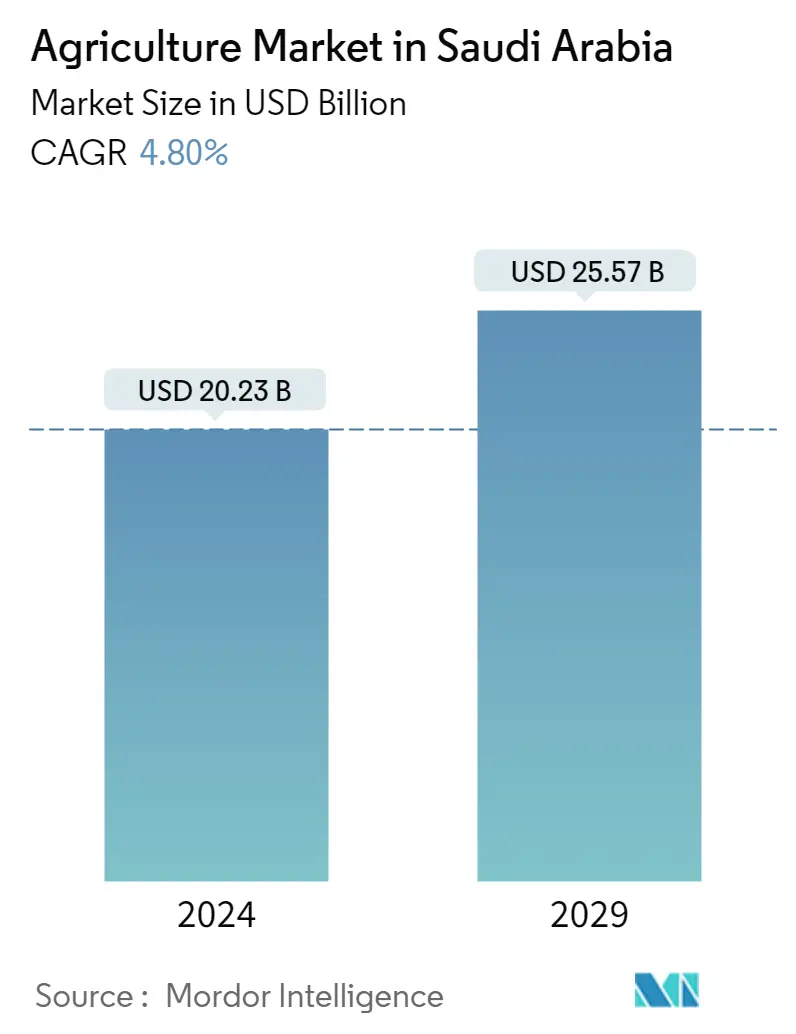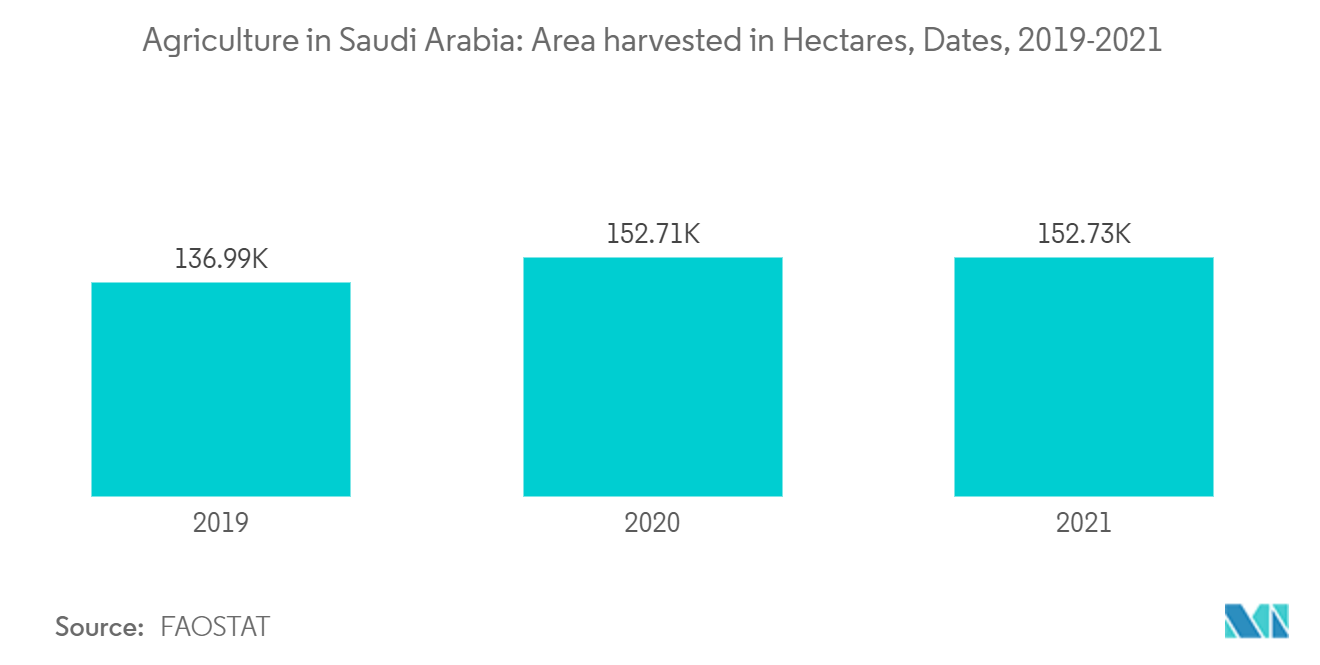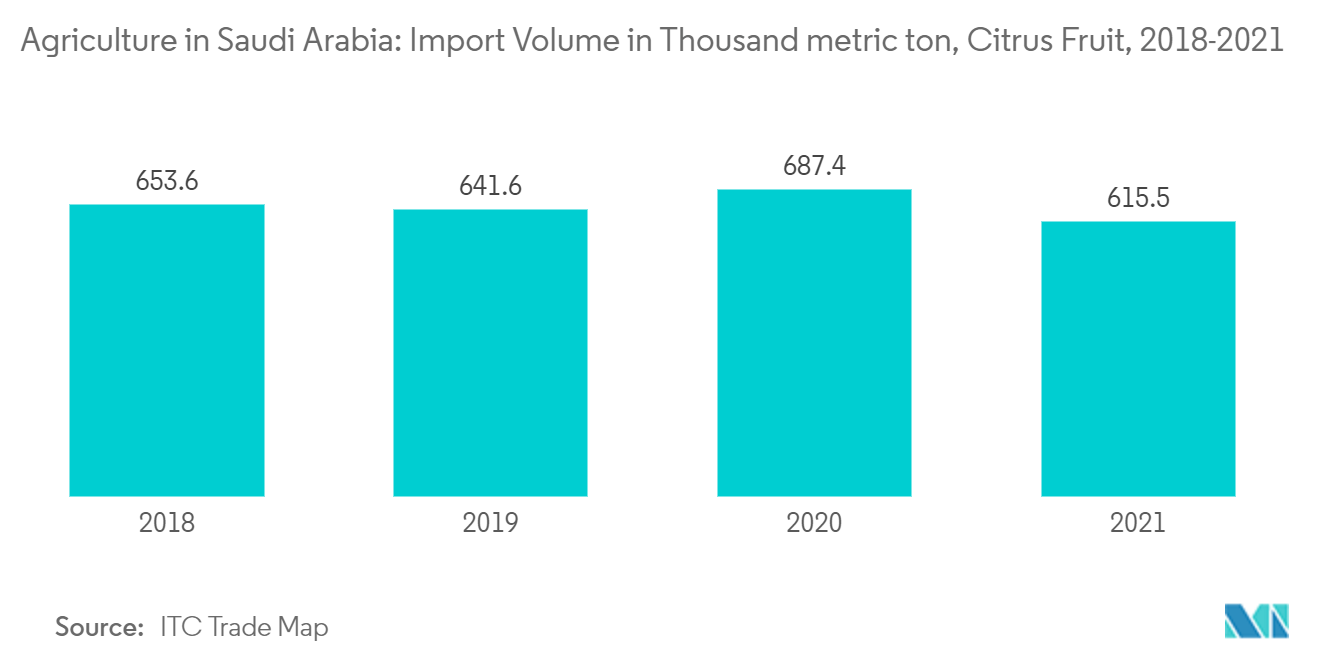Saudi Arabia Agriculture Market Size

| Study Period | 2017-2027 |
| Base Year For Estimation | 2021 |
| Forecast Data Period | 2023 - 2028 |
| Market Size (2023) | USD 19.30 Billion |
| Market Size (2028) | USD 24.40 Billion |
| CAGR (2023 - 2028) | 4.80 % |
Need a report that reflects how COVID-19 has impacted this market and its growth?
Saudi Arabia Agriculture Market Analysis
The Agriculture Market in Saudi Arabia is estimated at USD 19.30 billion in 2023, and is expected to reach USD 24.40 billion by 2028, growing at a CAGR of 4.80% during the forecast period (2023-2028).
- Saudi Arabia is the largest market for agriculture in the GCC region, and the demand for agriculture is higher at present in the country, owing to changing consumption patterns of consumers and increasing awareness. The agricultural sector contributes 53 billion SR annually to the country's GDP. The increase in population in the past few years also raised the importance of agriculture in this region.
- Additionally, the government of Saudi Arabia is highly supportive of favorable policies to support agriculture in the region. For instance, the Grain Silos and Flour mills Organization, purchases and stores wheat, constructs flour mills and produces animal feed. The government also offers land distribution and reclamation programs and funds research projects.
- Moreover, the increase in the income levels of the people and the high presence of superstores and hypermarkets has increased purchasing power and access to high-quality agricultural products for the Saudi population. As many of these retailers adopt strategies, including optimal pricing strategies to capture the market, the demand among consumers is increasing. The urban population is gradually becoming brand conscious and is becoming aware of the origin and type of food consumed.
Saudi Arabia Agriculture Market Trends
This section covers the major market trends shaping the Saudi Arabia Agriculture Market according to our research experts:
Technological advancements and increase in land under Agriculture are Driving the Market
Water is very scarce in Saudi Arabia due to the presence of large desert land. To encourage farming in the region many alternative sustainable agricultural activities, such as greenhouse farming and implementing advanced drip irrigation practices, to produce fruits and vegetables. This promotes the cultivation of different varieties of fruits, vegetables, and grains for the sustainable development of the nation and becomes the best solution for water scarcity.
Additionally, the technological advances to increase productivity and catering demand is showing a positive trend in the agriculture market of Saudi Arabia. For instance, in 2022 KSA announced a smart farm project which will supply fresh agricultural produce to the Saudi Arabia market. This project is a joint venture between Saudi supermarket chain Tamimi Markets, Japan-based Mitsui & Co., and Italian agricultural technology provider Zero SRL aims to develop vertical smart farms in the Al Kharj area of the kingdom. Such technological developments in the field of agriculture will help increase the farmer’s income and also strengthen the agriculture sector in Saudi Arabia.
Along with this, there are many start-up companies in the Saudi Arabia region that are taking up a wide range of technological approaches to innovate the agriculture industry. For instance, Red Sea Farms is an agricultural technology business that makes it possible to grow crops commercially using mostly salt water.
Moreover, the increased arable land year after year shows an increase in the demand for food products showing development in agriculture. For instance, As per the FAO, in 2020, the total area harvested under dates was 152,705 ha, up from 136,992 ha in 2019. Crops like dates, citrus, watermelon, grapes, tomatoes, and cabbage are majorly cultivated in the country, with dates and tomatoes holding the major share.

Increase in Government initiatives to attain agricultural self-sufficiency in the country
According to the Borgen Project, the Saudi Arabian Kingdom imports more than 80% of its necessary food supply with its oil money. Only about 1.5% of the land area of Saudi Arabia is arable, and the agriculture done in the country ends up taking over 80% of the Kingdom’s water supply. This is increasing the imports of various food to the country in order to satisfy the increased demand. For instance, according to the ITC trade map, the import volume of citrus increased from 653.6 metric ton in 2018 to 615.5 metric ton in 2021. So to reduce import dependency the government is taking various initiatives to attain self-sufficiency in agriculture production.
While the country is currently food-secure, farming in Saudi Arabia has been a crucial area of interest for those who wish to expand Saudi sustainability and shore up potential risks in global food supply network crashes. To avoid the uncertainty and the risks related to the food supply, the country’s government now, subsidizes the use of manufactured feed for livestock farmers and encourages vegetable growth using greenhouses and drip irrigation methods. These techniques conserve water while ensuring a more sustainable food supply.
Along with this, the Saudi government has made concerted efforts to improve its agricultural sector as part of its Vision 2030 program. Saudi Arabia's Vision 2030 is focused on rationalizing the use of finite resources and increasing efficiency through production and value chains. The development of rural economies is a top priority. To assist them in achieving their objectives under the government's 2030 economic plan, Saudi Arabia has approved financial support for the environment, water, and agriculture sectors totaling 92 billion riyals (USD24.5 billion). Similarly, as a part of Vision 2030, the Saudi government is spending worth 13.94 billion riyals on the Ministry of Agriculture as a part of the National Transformation Plan.
Moreover, the Saudi Arabian Agricultural Bank (SAAB) is a government agency that offers subsidies to small and medium land-holding farmers. It also credits interest-free loans and supports the growers financially. Such government initiatives to support the agricultural sector in the country is expected to boost the growth of the agriculture market.

Saudi Arabia Agriculture Market News
August 2022: The Kingdom of Saudi Arabia plans to increase its production of dragon fruit because it is a highly prized commodity and uses less water than other agricultural crops. The announcement was made at a workshop hosted by the Ministry of Environment, Water, and Agriculture.
September 2022: Saudi Arabia in its plans to invest heavily in its food and agricultural sectors. Abdulrahman Al Fadhli, the country’s minister of environment, water, and agriculture, said that the government was allocating 91 billion riyals (USD 24.4 billion) for food and agriculture industries in a bid to boost production and exports.
July 2021: The Ministry of Environment, Water and Agriculture of the Kingdom of Saudi Arabia has launched a new mechanism for applying the terms and conditions for importing vegetables and fruits, as of Muhrram 1, 1443, the beginning of the New Hijri Year, corresponding to August 10, 2021. They announced that the mechanism’s main objective is to back up the sustainability of local production and quality control, preserving the agricultural resources and continuing fresh vegetables and fruits flow to consolidate food security.
Saudi Arabia Agriculture Market Report - Table of Contents
1. INTRODUCTION
1.1 Study Assumptions and Market Definition
1.2 Scope of the Study
2. RESEARCH METHODOLOGY
3. EXECUTIVE SUMMARY
4. MARKET DYNAMICS
4.1 Market Overview
4.2 Market Drivers
4.3 Market Restraints
5. MARKET SEGMENTATION
5.1 Type (Production Analysis by Volume, Consumption Analysis by Volume and Value, Import Analysis by Volume and Value, Export Analysis by Volume and Value, and Price Trend Analysis)
5.1.1 Food Crops/Cereals
5.1.2 Fruits
5.1.3 Vegetables
5.1.4 Oilseeds and Pulses
6. INTERNATIONAL TRADE AND PRICE SCENARIOS
6.1 Onion
6.2 Potato
6.3 Tomato
6.4 Garlic
6.5 Cauliflower
6.6 Beans
6.7 Eggplant
6.8 Lemon
6.9 Apples
6.10 Banana
6.11 Grapes
6.12 Strawberry
6.13 Watermelon
6.14 Dates
6.15 Olives
7. REGIONAL ANALYSIS
7.1 PESTLE Analysis
7.2 Value/Supply Chain Analysis
7.3 Government Policies
8. COMPETITIVE ANALYSIS
8.1 Distribution Network and Retail Analysis
8.2 List/Profile of Key Players
9. MARKET OPPORTUNITIES & FUTURE TRENDS
Saudi Arabia Agriculture Industry Segmentation
Saudi Arabia's agriculture is entirely dependent on winter rainfall. The major agricultural crops grown are wheat, sorghum, barley, millet, tomato, watermelon, eggplant, potato, cucumber, onions, date palm, citrus, grapes, and alfalfa. In Saudi Arabia, agriculture has witnessed a drastic change by converting large desert areas into productive farmlands by using the latest and advanced technologies.
The Saudi Arabian Agriculture Market is segmented by Type into Food Crops or Grains, Fruits, Vegetables, Oilseeds, and Pulses. The report includes Production Analysis (Volume), Consumption Analysis (Value and Volume), Export Analysis (Value and Volume), Import Analysis (Value and Volume), and Price Trend Analysis. The report offers market size and forecasts in terms of value(USD million) and volume (metric ton) for all the above segments.
| Type (Production Analysis by Volume, Consumption Analysis by Volume and Value, Import Analysis by Volume and Value, Export Analysis by Volume and Value, and Price Trend Analysis) | |
| Food Crops/Cereals | |
| Fruits | |
| Vegetables | |
| Oilseeds and Pulses |
Saudi Arabia Agriculture Market Research FAQs
How big is the Saudi Arabia Agriculture Market?
The Saudi Arabia Agriculture Market size is expected to reach USD 19.30 billion in 2023 and grow at a CAGR of 4.80% to reach USD 24.40 billion by 2028.
What is the current Saudi Arabia Agriculture Market size?
In 2023, the Saudi Arabia Agriculture Market size is expected to reach USD 19.30 billion.
Agriculture in Saudi Arabia Industry Report
Statistics for the 2023 Agriculture in Saudi Arabia market share, size and revenue growth rate, created by Mordor Intelligence™ Industry Reports. Agriculture in Saudi Arabia analysis includes a market forecast outlook to 2028 and historical overview. Get a sample of this industry analysis as a free report PDF download.
